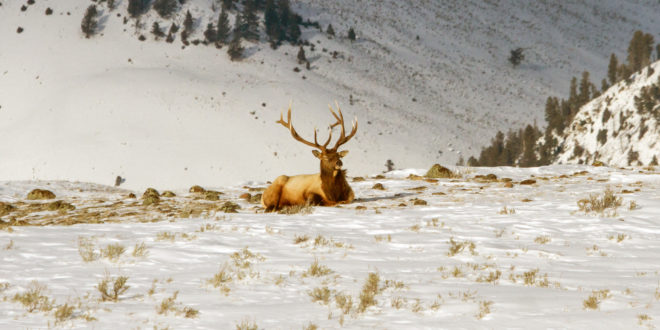Elk numbers are up in northern Yellowstone, according to a recent survey from the Northern Yellowstone Wildlife Working Group. Further, more are migrating into Montana.
According to the Bozeman Daily Chronicle, state and federal biologists logged 5,349 elk in Yellowstone’s northern range and around Gardiner earlier this month. That’s nine percent higher than the count made in January 2016, which was the highest elk count since 2010. From the Chronicle:
“We’ve come up from that low point and the last three years the herd has seemed to be pretty stable,” said Karen Loveless, an area biologist for Montana Fish, Wildlife and Parks.
The number is considered a minimum count — biologists counted only the elk that they saw, and there may be more that they did not see. Doug Smith, a biologist with Yellowstone, said the margin of error varies, but that there might be as much as 30 percent more elk than they counted. Still, they are confident the count means elk are doing relatively well there.
It’s still a far cry from where the population was in 1994, when biologists counted 19,000 there. But in the following years, the animal’s number there plummeted, reaching a low point in 2013, when biologists counted 3,900. The decline coincided with the reintroduction of wolves to the region, which many blame for the drastic decline in elk numbers.
Loveless and other biologists caution against giving wolves too much credit for the decline, saying there were other factors besides the canine predators alone. But she did say the stabilization of the elk population in recent years could be a sign that some sort of balance has been struck in that predator-prey relationship. Since 2008, the number of wolves in the region has declined significantly. Meanwhile, elk numbers have inched upward.
“We do know wolf numbers are lower than what they were,” she said. “We might be at a point of better equilibrium between the wolves and the elk.”
But a decline in wolves doesn’t mean the elk have no pressure from predators. Smith said while wolves have declined, they haven’t disappeared and are likely still putting pressure on elk. And, he said, the animals still face dangers from cougars and both grizzly and black bears.
The biologists didn’t comment directly on why more elk are migrating into Montana. According to the Chronicle, 4,776 elk were noted outside Yellowstone’s boundaries, nearly 1,000 more than in 2016. Further, it’s the highest count of elk wintering outside Yellowstone since 2002. From the Chronicle:
Records included in the report show that it was normal for 40 percent or more of the elk to spend winters inside the park. But in the last five years, that has been changing. Before 2017’s count, biologists recorded 77 percent of their elk sightings outside of Yellowstone for four consecutive years.
“Things have flip-flopped,” Smith said. “A lot more elk used to winter in Yellowstone.”
But biologists can’t point to a definitive reason why the elk are migrating out in greater number. Harsher winter conditions can push elk to lower elevations outside of the park, but Loveless said this winter hasn’t been especially tough on the animals. Smith said it could be because of threats from predator species and the lack of a late season elk hunt in the state hunting districts along the park’s border.
Loveless added that the increase in elk outside Yellowstone National Park could lead to more conflicts between landowners and wildlife, saying her agency will “continue to work with those people with all the tools we have to reduce conflicts.”
 Yellowstone Insider Your Complete Guide to America's First National Park
Yellowstone Insider Your Complete Guide to America's First National Park





